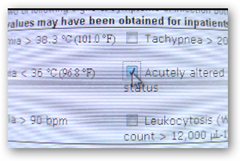After deployed the very first alert initiated an attending physician to begin antibiotic therapy for a patient. They average 3-4 alerts daily in a 25 bed ICU unit. Work has just started on adapting the language and knowledge to chronic heart failure. I originally posted this story back in March of 2008 with the start of the project. 
The hospital felt they were only getting to about half the the patients in time to avoid organ and other damage. As is mentioned in the video, they are not doing labs or any other reporting here, just monitoring the patient. With Sepsis time of of the essence. The related reading below has some additional information and posts. Nice work for Vanderbilt and bringing all the creative minds together. The second phase was to bring Sepsis management into the process from the alert stage and that has now been done as well, so on to using the basis of PSST for other acute and emergency monitoring and management services. BD
Microsoft's Patient Safety Screening Tool - PSST
Microsoft offers a solution that helps with just that. The Patient Safety Screening Tool (PSST) for Sepsis equips providers with powerful workflow tools to help them detect morbidities early and consistently administer evidence-based practices based on guidelines from the Surviving Sepsis Campaign and Institute for Healthcare Improvement (IHI), which have teamed up to achieve a 25 percent reduction in sepsis mortality by 2009. Built on the Microsoft platform using solutions such as Microsoft Office InfoPath, SharePoint Server 2007, Windows Server 2008 and SQL Server, PSST for Sepsis can also incorporate a facility's specific best practices and is designed to support the way clinicians work, seamlessly integrating with existing systems.
The team is made up of clinicians and informatics experts from the Vanderbilt University Medical Center and computer scientists from Vanderbilt's Institute for Software Integrated Systems (ISIS). They have developed and begun testing what they believe is the first real-time system for sepsis detection. In May, the system was deployed in the hospital's intensive care unit to test its effectiveness. This summer, they will add an automated decision support system designed to guide attending physicians through the complex process of sepsis treatment.

"This is an effort to use the power of informatics to move from reactive to proactive medical treatment by creating tools to support the use of evidence-based clinical guidelines," said Peter Miller, director of the Vanderbilt HealthTech Laboratory, who oversees the project.
Sepsis, or systemic inflammatory response syndrome (SIRS), causes the body to attack itself. It is triggered when bacteria invade the body from outside through wounds or IV lines. The bacterial infection over stimulates the body's immune system, setting off a cascade of inflammatory and abnormal clotting responses that can lead to organ failure and death. Infections that cause sepsis can be acquired outside the hospital, but those acquired in the hospital are more difficult to manage because many patients are already weak and the invading bacteria are more likely to be drug-resistant strains.The first part of the project was the development of an automated early detection system that can alert doctors that a patient may be developing sepsis. The doctors came up with a formula involving patient temperature, heart rate, respiration rate and white blood count that they felt was indicative of the onset of SIRS. Currently, the alerts appear on "patient dashboards" displayed on ICU workstations. (In the future, they hope to add the capability of displaying the alert on doctors' cell phones.) When a doctor gets an alert, she checks out the patient. If she decides it was a false alarm, the system goes to sleep for 48 hours before resuming operation. If she decides the system was right and begins treatment, the alert system turns off for a week.
After a period of "beating our heads against the wall trying to make this work," the ISIS team suggested a new approach, something they called a "state-based decision engine." Essentially, this involved breaking down the guidelines into a series of independent processes that can take place sequentially or simultaneously. "This really captures the way doctors work. If we see low blood pressure, then we think of one set of treatments. If we see low blood sugar, then we think of another set. If we see the two together, then we consider a third set of possible measures we can take," Martin said. "The more we kicked it around, the more we liked it."
Scientists Pioneer An Advanced Sepsis Detection And Management System - Health News - redOrbit
Related Reading:







0 comments :
Post a Comment